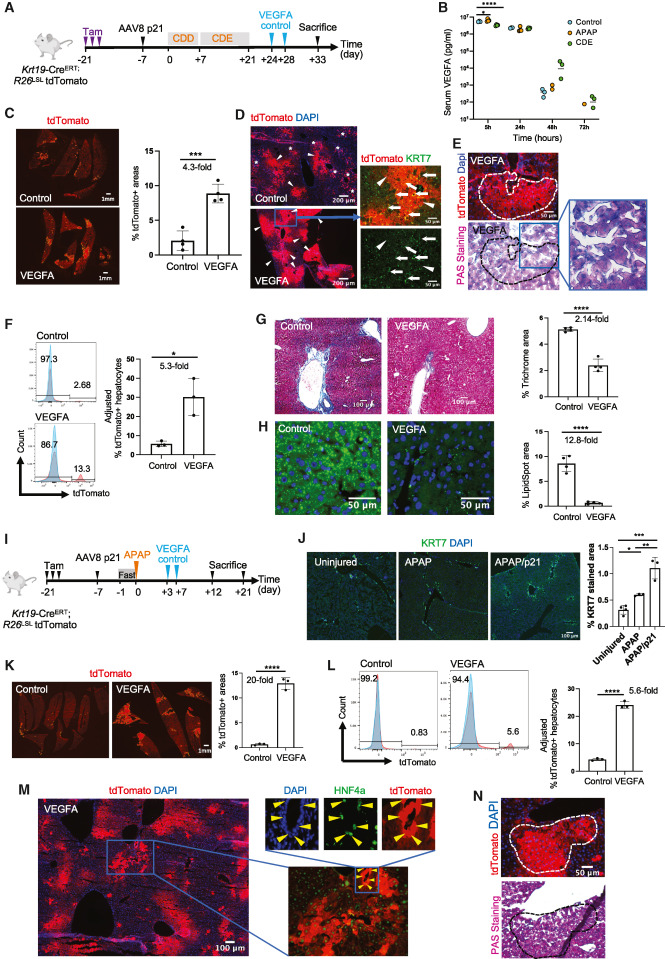Fig. 2 VEGFA mRNA-LNP induces BEC-to-hepatocyte conversion and promotes liver repair in chronic CDE/p21 and acute APAP/p21 liver-injury models in Krt19-CreERT,R26LSLtdTomato mice (A) Schematic depicting CDE/p21 injury model in female mice. (B) Human-specific VEGFA ELISA from sera of uninjured control (n = 3), and mice injured with APAP (n = 4) or CDE (n = 4). (C) Stitched images of tdTomato+ clusters (outlined yellow) in livers from CDE/p21 injured mice. Quantification of tdTomato+ areas in both groups. (D) tdTomato+ (red) and KRT7+ (green) cells in the CDE/p21 model. Closeup images of tdTomato+ hepatocytes (arrowheads) adjacent to tdTomato+KRT7+ BECs (arrows) in VEGFA mRNA-LNP-treated mice. Asterisks represent tdTomato+ BECs. (E) tdTomato and PAS staining of serial sections of liver tissue showing glycogen storage in tdTomato+ hepatocytes in CDE/p21 model. (F) Representative histograms from flow cytometry of hepatocyte fractions from female Krt19-CreERT,R26LSLtdTomato mice treated as shown in Figure 2A. Red histograms represent the percentage of tdTomato+ populations within the hepatocyte fractions. Blue histograms represent hepatocytes from a control non-tdTomato background. Calculation of the percentage of tdTomato+ hepatocytes by extrapolating the lineage-tracing efficiency as 100% across all mice in CDE/p21 model. (G) Brightfield images and quantification of the percentage of trichrome-positive areas from three different fields in each mouse (n = 4 mice per treatment) in CDE/p21 model. (H) Images of LipidSpot staining showing lipids (green) in hepatocytes and quantification of the percentage of LipidSpot-stained areas from three different fields in each mouse (n = 4 mice per treatment) in CDE/p21 model. (I) Schematic depicting APAP/p21 injury model in female mice. (J) Immunofluorescence images and quantification of KRT7+ BECs in APAP or APAP/p21 models 12 days after APAP. (K) Stitched immunofluorescence images of tdTomato+ areas (outlined in yellow) in APAP/p21 model and quantification of tdTomato+ areas. (L) Representative histograms from flow cytometry of hepatocyte fractions isolated 21 days after APAP from male Krt19-CreERT,R26LSLtdTomato mice treated as shown in Figure 2I with 300 mg/kg APAP. Red histograms represent percentage of tdTomato+ populations within the hepatocyte fractions, and blue histograms represent the hepatocytes from a control non-tdTomato background. Calculation of the percentage of tdTomato+ hepatocytes by extrapolating the lineage-tracing efficiency as 100% across all mice. (M) Immunofluorescence images of tdTomato+ hepatocyte (arrows) in APAP/p21 model co-stained with HNF4A (green) 21 days after injury. Closeup images of HNF4A+ cells within a tdTomato+ biliary duct. (N) tdTomato and PAS staining of serial sections of liver demonstrating glycogen storage in tdTomato+ hepatocytes in APAP/p21 model 21 days after injury. Numerical data are presented as mean ± S.D. Two-tailed Student’s t test; ∗p < 0.05, ∗∗p < 0.01, ∗∗∗p < 0.001, ∗∗∗∗p < 0.0001. See also Figures S2 and S3.
Image
Figure Caption
Acknowledgments
This image is the copyrighted work of the attributed author or publisher, and
ZFIN has permission only to display this image to its users.
Additional permissions should be obtained from the applicable author or publisher of the image.
Full text @ Cell Stem Cell

